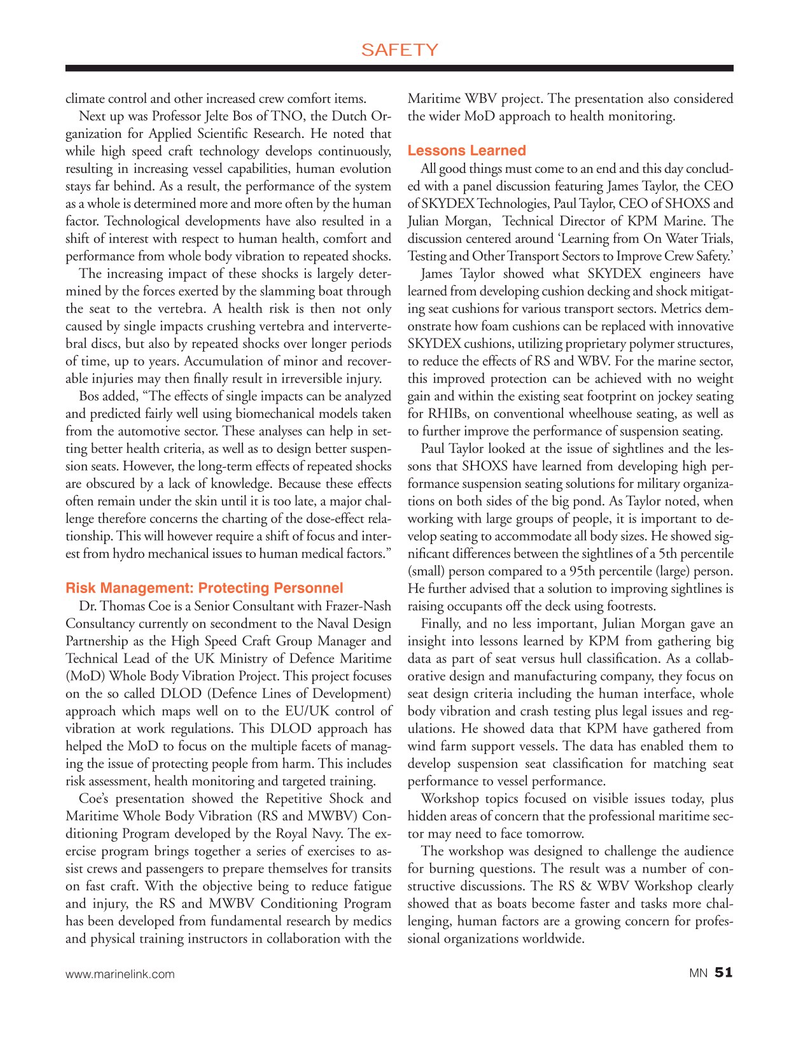
Page 51: of Marine News Magazine (July 2017)
Propulsion Technology
Read this page in Pdf, Flash or Html5 edition of July 2017 Marine News Magazine
SAFETY climate control and other increased crew comfort items. Maritime WBV project. The presentation also considered
Next up was Professor Jelte Bos of TNO, the Dutch Or- the wider MoD approach to health monitoring.
ganization for Applied Scienti? c Research. He noted that while high speed craft technology develops continuously, Lessons Learned resulting in increasing vessel capabilities, human evolution All good things must come to an end and this day conclud- stays far behind. As a result, the performance of the system ed with a panel discussion featuring James Taylor, the CEO as a whole is determined more and more often by the human of SKYDEX Technologies, Paul Taylor, CEO of SHOXS and factor. Technological developments have also resulted in a Julian Morgan, Technical Director of KPM Marine. The shift of interest with respect to human health, comfort and discussion centered around ‘Learning from On Water Trials, performance from whole body vibration to repeated shocks. Testing and Other Transport Sectors to Improve Crew Safety.’
The increasing impact of these shocks is largely deter- James Taylor showed what SKYDEX engineers have mined by the forces exerted by the slamming boat through learned from developing cushion decking and shock mitigat- the seat to the vertebra. A health risk is then not only ing seat cushions for various transport sectors. Metrics dem- caused by single impacts crushing vertebra and interverte- onstrate how foam cushions can be replaced with innovative bral discs, but also by repeated shocks over longer periods SKYDEX cushions, utilizing proprietary polymer structures, of time, up to years. Accumulation of minor and recover- to reduce the effects of RS and WBV. For the marine sector, able injuries may then ? nally result in irreversible injury. this improved protection can be achieved with no weight
Bos added, “The effects of single impacts can be analyzed gain and within the existing seat footprint on jockey seating and predicted fairly well using biomechanical models taken for RHIBs, on conventional wheelhouse seating, as well as from the automotive sector. These analyses can help in set- to further improve the performance of suspension seating. ting better health criteria, as well as to design better suspen- Paul Taylor looked at the issue of sightlines and the les- sion seats. However, the long-term effects of repeated shocks sons that SHOXS have learned from developing high per- are obscured by a lack of knowledge. Because these effects formance suspension seating solutions for military organiza- often remain under the skin until it is too late, a major chal- tions on both sides of the big pond. As Taylor noted, when lenge therefore concerns the charting of the dose-effect rela- working with large groups of people, it is important to de- tionship. This will however require a shift of focus and inter- velop seating to accommodate all body sizes. He showed sig- est from hydro mechanical issues to human medical factors.” ni? cant differences between the sightlines of a 5th percentile (small) person compared to a 95th percentile (large) person.
Risk Management: Protecting Personnel He further advised that a solution to improving sightlines is
Dr. Thomas Coe is a Senior Consultant with Frazer-Nash raising occupants off the deck using footrests.
Consultancy currently on secondment to the Naval Design Finally, and no less important, Julian Morgan gave an
Partnership as the High Speed Craft Group Manager and insight into lessons learned by KPM from gathering big
Technical Lead of the UK Ministry of Defence Maritime data as part of seat versus hull classi? cation. As a collab- (MoD) Whole Body Vibration Project. This project focuses orative design and manufacturing company, they focus on on the so called DLOD (Defence Lines of Development) seat design criteria including the human interface, whole approach which maps well on to the EU/UK control of body vibration and crash testing plus legal issues and reg- vibration at work regulations. This DLOD approach has ulations. He showed data that KPM have gathered from helped the MoD to focus on the multiple facets of manag- wind farm support vessels. The data has enabled them to ing the issue of protecting people from harm. This includes develop suspension seat classi? cation for matching seat risk assessment, health monitoring and targeted training. performance to vessel performance.
Coe’s presentation showed the Repetitive Shock and Workshop topics focused on visible issues today, plus
Maritime Whole Body Vibration (RS and MWBV) Con- hidden areas of concern that the professional maritime sec- ditioning Program developed by the Royal Navy. The ex- tor may need to face tomorrow.
ercise program brings together a series of exercises to as- The workshop was designed to challenge the audience sist crews and passengers to prepare themselves for transits for burning questions. The result was a number of con- on fast craft. With the objective being to reduce fatigue structive discussions. The RS & WBV Workshop clearly and injury, the RS and MWBV Conditioning Program showed that as boats become faster and tasks more chal- has been developed from fundamental research by medics lenging, human factors are a growing concern for profes- and physical training instructors in collaboration with the sional organizations worldwide.
51 www.marinelink.com MN

 50
50

 52
52
